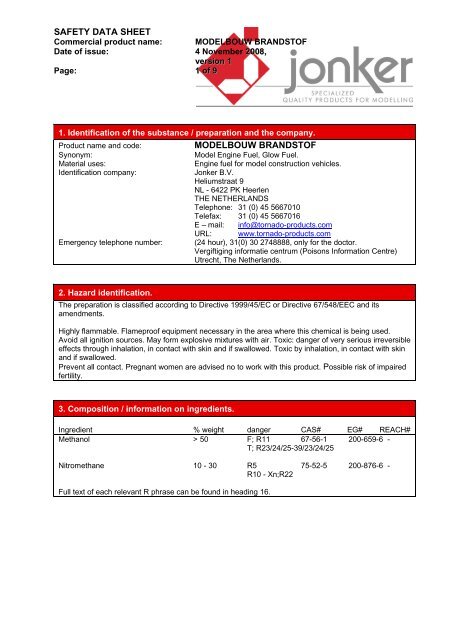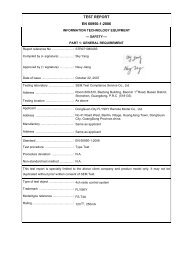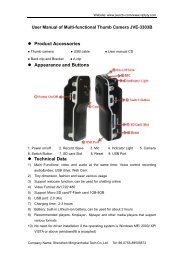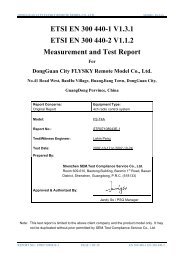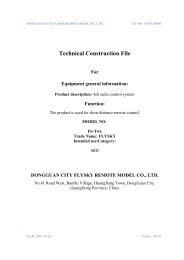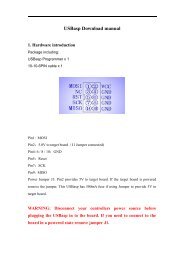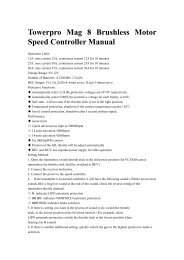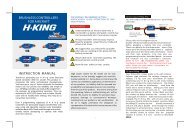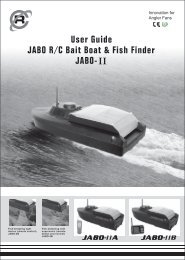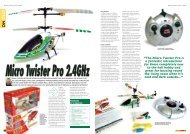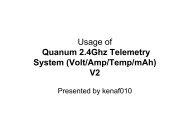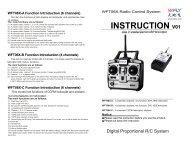SAFETY DATA SHEET MODELBOUW BRANDSTOF - Propeleris
SAFETY DATA SHEET MODELBOUW BRANDSTOF - Propeleris
SAFETY DATA SHEET MODELBOUW BRANDSTOF - Propeleris
Create successful ePaper yourself
Turn your PDF publications into a flip-book with our unique Google optimized e-Paper software.
<strong>SAFETY</strong> <strong>DATA</strong> <strong>SHEET</strong><br />
Commercial product name: <strong>MODELBOUW</strong> <strong>BRANDSTOF</strong><br />
Date of issue: 4 November 2008,<br />
version 1<br />
Page: 1 of 9<br />
1. Identification of the substance / preparation and the company.<br />
Product name and code: <strong>MODELBOUW</strong> <strong>BRANDSTOF</strong><br />
Synonym: Model Engine Fuel, Glow Fuel.<br />
Material uses: Engine fuel for model construction vehicles.<br />
Identification company: Jonker B.V.<br />
Heliumstraat 9<br />
NL - 6422 PK Heerlen<br />
THE NETHERLANDS<br />
Telephone: 31 (0) 45 5667010<br />
Telefax: 31 (0) 45 5667016<br />
E – mail: info@tornado-products.com<br />
URL: www.tornado-products.com<br />
Emergency telephone number: (24 hour), 31(0) 30 2748888, only for the doctor.<br />
Vergiftiging informatie centrum (Poisons Information Centre)<br />
Utrecht, The Netherlands.<br />
2. Hazard identification.<br />
The preparation is classified according to Directive 1999/45/EC or Directive 67/548/EEC and its<br />
amendments.<br />
Highly flammable. Flameproof equipment necessary in the area where this chemical is being used.<br />
Avoid all ignition sources. May form explosive mixtures with air. Toxic: danger of very serious irreversible<br />
effects through inhalation, in contact with skin and if swallowed. Toxic by inhalation, in contact with skin<br />
and if swallowed.<br />
Prevent all contact. Pregnant women are advised no to work with this product. Possible risk of impaired<br />
fertility.<br />
3. Composition / information on ingredients.<br />
Ingredient % weight danger CAS# EG# REACH#<br />
Methanol > 50 F; R11 67-56-1 200-659-6 -<br />
T; R23/24/25-39/23/24/25<br />
Nitromethane 10 - 30 R5 75-52-5 200-876-6 -<br />
R10 - Xn;R22<br />
Full text of each relevant R phrase can be found in heading 16.
<strong>SAFETY</strong> <strong>DATA</strong> <strong>SHEET</strong><br />
Commercial product name: <strong>MODELBOUW</strong> <strong>BRANDSTOF</strong><br />
Date of issue: 4 November 2008,<br />
version 1<br />
Page: 2 of 9<br />
4. First – aid measures.<br />
Eye contact: Remove possible contact lenses. Contamination of the eyes<br />
must be treated by thorough irrigation with water for 15<br />
minutes, with the eyelids held open. A doctor (or eye specialist)<br />
should be consulted immediately.<br />
Skin contact: Remove contaminated clothing promptly. Wash thoroughly with<br />
plenty of soap and water.<br />
Swallowing: Provided the patient is conscious, wash out mouth with water.<br />
DO NOT induce patient to vomit. If less than 15 minutes from a<br />
hospital, transport patient immediately to hospital/medical<br />
centre. If medical assistance is not immediately available,<br />
carefully induce vomiting, protecting against aspiration of<br />
material into the lungs, by placing patient head lower than<br />
knees. Use fingers, Ipecac Syrup (APF) or similar emetic.<br />
Continue to seek medical assistance. The person should be<br />
placed and kept in the recovery position if unconscious.<br />
If aerosol or vapour is inhaled<br />
in high concentrations: Remove victim from exposure - avoid becoming a casualty. If<br />
breathing laboured and patient cyanotic (blue), ensure airways<br />
are clear and have qualified person give oxygen through a face<br />
mask. If breathing has stopped apply artificial respiration at<br />
once. In the event of cardiac arrest, apply external cardiac<br />
massage. For all but the most minor symptoms arrange for<br />
patient to be seen by a doctor as soon as possible - either on<br />
site or at the nearest hospital.<br />
Further medical treatment: Watch for toxic effects which may be delayed, including<br />
chemical pnuemonitis. Contact Poisons Information Centre for<br />
antidote treatment with ethyl alcohol. Central nervous system<br />
depression, and acidosis from methanol metabolites, including<br />
formaldehyde, liver function and optic nerve, and other effects<br />
should be treated symptomatically.<br />
5. Fire – fighting measures.<br />
Extinguishing media suitable: Carbon dioxide. Dry chemical. Foam. Large quantities of water.<br />
Extinguishing media which must not be used for safety reasons: Water jet and powder (dry chemical<br />
extinguishers).<br />
Special exposure hazards arriving from substance or preparation itself, combustion products, resulting<br />
gases: Highly flammable liquid. If involved in a fire, it may emit noxious<br />
and toxic fumes. In case of fire and/or explosion do not breathe<br />
fumes. Combustion products may include: carbon monoxide,<br />
nitrogen oxides and carbon dioxide. Vapors may travel a<br />
considerable distance to a source of ignition and flashback.<br />
Take a safe distance during extinguishing.<br />
Protection of fire-fighters: Fire - men have to wear self - contained breathing apparatus.<br />
Use qualified personnel who are well aware of the dangers of<br />
this product. After use clean the equipment thoroughly (shower,<br />
clean clothing thoroughly and check suitability).<br />
Additional information: Heating can cause expansion or decomposition leading to<br />
violent rupture of containers. Keep containers cool with water<br />
spray. Product or residue can ignite explosively when exposed<br />
to fire.
<strong>SAFETY</strong> <strong>DATA</strong> <strong>SHEET</strong><br />
Commercial product name: <strong>MODELBOUW</strong> <strong>BRANDSTOF</strong><br />
Date of issue: 4 November 2008,<br />
version 1<br />
Page: 3 of 9<br />
6. Accidental release measures.<br />
Personal precautions: People dealing with major spillages should wear personal<br />
protective clothing (filter mask for organic gases and vapors).<br />
Do not approach without full protective clothing. Shut off all<br />
possible sources of ignition. Remove any naked lights and<br />
strong heat sources. Evacuate unprotected personnel from<br />
danger area. Move them upwind. Send message to notify<br />
emergency services. For large spills, or tank ruptures, consider<br />
initial evacuation distance of 200 meters in all directions. If<br />
available use water spray to disperse vapor. Seek contact with<br />
a specialist.<br />
Environmental precautions: Do not discharge into drains or sewers. Isolate leaking<br />
containers and stop leak if safe to do so. If significant quantities<br />
are being released in the environment, inform the authorities<br />
according to the local rules.<br />
Clean up methods: Spills should be neutralized with alkaline material (soda ash,<br />
lime), further contained by, and covered with large quantities of<br />
sand, earth or any other non-combustible absorbent material<br />
which is then brushed in vigorously to assist absorption. The<br />
mixture can then be collected into drums and removed for<br />
disposal. Wash area from residues with soap and large<br />
quantities of water and rinse down. Contaminated water should<br />
be retained, not being allowed to flow into ground or surface<br />
water.<br />
7. Handling and storage.<br />
Handling: STRICT HYGIENE! Prevent exposure by following strict<br />
hygiene procedures. Avoid contact with eyes, skin and clothing.<br />
Ensure good ventilation/exhaustion at the workplace. Handle<br />
carton and cans with care. Avoid dropping Keep ignition<br />
sources away - Do not smoke. Nearby equipment must be<br />
earthed. Protect against electrostatic charges. Never use<br />
welding or cutting torch on or near (empty) product containers.<br />
Storage: Keep container tightly closed when not in use. Keep away from<br />
sources of heat and direct sunlight. Separated from amines,<br />
alkalis and acids – dry alkali, amine salts, inorganic acids,<br />
aldehydes, alkylene oxides, halogens, acid anhydrides,<br />
monomers and polymerisable esters. Prevent product<br />
temperatures above 30 °C and below -15 °C. Keep separated<br />
from foodstuff.<br />
Suitable storage material: Original packaging.<br />
Storage material to avoid: -<br />
Storage temperature: Recommended storage<br />
temperature 5 - 30 °C.<br />
Classification storage (NL): Classified according to PGS15.<br />
Specific use(s): Engine fuel for model construction vehicles. Prevent contact<br />
during filling.
<strong>SAFETY</strong> <strong>DATA</strong> <strong>SHEET</strong><br />
Commercial product name: <strong>MODELBOUW</strong> <strong>BRANDSTOF</strong><br />
Date of issue: 4 November 2008,<br />
version 1<br />
Page: 4 of 9<br />
8. Exposure controls / personal protection.<br />
Limits of exposure.<br />
Name component Occupational exposure limits and source.<br />
Methanol TWA (8 hrs) 266 mg/m 3 (200 ppm)<br />
Short term (15 minutes) 333 mg/m 3 (250 ppm)<br />
UK EH40 Workplace exposure limits also EU limits<br />
Nitromethane TWA (8 hrs) 254 mg/m 3 (100 ppm)<br />
Short term (15 minutes) 381 mg/m 3 (150 ppm)<br />
UK EH40 Workplace exposure limits<br />
Personal protective equipment: Do not eat or drink or smoke whilst working with the product.<br />
Practice strict personal hygiene.<br />
Respiratory protection: Where the air concentration approaches the exposure standard<br />
the following respiratory protection is recommended: Short<br />
elevated exposure - organic filter respirator (EN 371 filter type<br />
AX/P3). If exposures greater than ten time the TWA - use air<br />
line respirators. Prolonged elevated exposure - air line<br />
respirator.<br />
Skin and body: Wear suitable protective clothing (preferable heavy cotton or<br />
disposable coverall with a PVC splash apron). Hands and all<br />
body parts that have come into contact with the substance<br />
should be thoroughly washed in breaks and on termination of<br />
operations. Remove contaminated clothing immediately. Keep<br />
working clothes separate.<br />
Hands: Always wash hands and face before eating, drinking, toilet and<br />
work breaks. Protective gloves should be worn when handling<br />
the product. For prolonged or repeated handling, use gloves:<br />
neoprene.<br />
Eyes: Close-fitting safety glasses (EN 166) or full face protection if<br />
splashing may occur.<br />
9. Physical and chemical properties.<br />
General information.<br />
Appearance: Liquid.<br />
Colour: Orange.<br />
Odour: Like alcohol.<br />
Important health, safety and environmental information.<br />
pH: -<br />
Boiling point: > 60 °C.<br />
Flash point: 10 - 23 °C.<br />
Melting point: - 95 °C.<br />
Self-ignition temperature: > 400 °C.<br />
Explosive properties: Explosive vapour-air mixtures may be formed between 4,4 and<br />
38,5 (V) % at 50 °C.<br />
Vapour pressure: 128 mbar at 20 °C.<br />
Relative density: ca. 0,88 at 20 °C (water = 1).<br />
Solubility in water: Partly soluble in water.<br />
Viscosity: 1 - 2 mPa.s at 20 °C.
<strong>SAFETY</strong> <strong>DATA</strong> <strong>SHEET</strong><br />
Commercial product name: <strong>MODELBOUW</strong> <strong>BRANDSTOF</strong><br />
Date of issue: 4 November 2008,<br />
version 1<br />
Page: 5 of 9<br />
10. Stability and reactivity.<br />
Stability: Stable at normal use.<br />
Conditions to avoid: Heat, sparks, and open flames.<br />
Materials to avoid: Strong oxidizing agents, aluminum, zinc, or metals that displace<br />
hydrogen, rubber, and rubber based coatings, chromic<br />
anhydride, lead perchlorate, perchloric acid, amines, strong<br />
acids, alkali’s, metal oxides, hydrocarbons, other materials, lead<br />
copper, and their alloys. Contains nitromethane which slowly<br />
corrodes steel and copper when wet.<br />
Hazardous decomposition products: No hazardous decomposition products when stored and<br />
handled correctly. Burning may produce carbon monoxide,<br />
carbon dioxide, nitrogen oxides which can be toxic by<br />
inhalation.<br />
11. Toxicological information.<br />
Acute toxicity from the components:<br />
Product information: Methanol.<br />
LD50 (oral, rat): 5.628 mg / kg.<br />
LD50 (dermal, rabbit): 15.800 mg / kg.<br />
LC50 (inhalation, rat): 85 mg / l (4 hours).<br />
Product information: Nitromethane.<br />
LD50 (oral, rat): 1.210 mg / kg.<br />
LD50 (dermal, rabbit): > 2.000 mg / kg.<br />
LC0 (inhalation, rat): > 12,75 mg / l (1 hour).<br />
This health hazard assessment is based on information of the components.<br />
Effects on the eyes: May cause watering of the eyes, stinging or blurred vision, and<br />
sensitivity to light. May cause irritation and corneal damage.<br />
Effects on the skin: Toxic by skin contact. Contact with skin will result in defatting<br />
and moderate irritation. May cause irritation, redness, and pain.<br />
Can be absorbed through the skin in harmful amounts.<br />
Effect on the respiratory organs: Toxic by inhalation. The vapour is irritating to the mucous<br />
membranes and respiratory tract. Inhalation of vapour can<br />
cause headache, nausea, central nervous system effects, and<br />
visual impairment, possibly blindness. Continued exposure can<br />
result in health effects as per ingestion.<br />
Ingestion: Toxic if swallowed. Ingestion can result in nausea, vomiting,<br />
severe abdominal pain, back pain, central nervous system<br />
effects including optic nerve damage (hyperemia etc.),<br />
convulsions, blindness, loss of consciousness and ultimately<br />
proceed to coma and death.<br />
Chronic Exposure: Prolonged, chronic exposure from skin contact, inhalation and<br />
swallowing of methanol can result in dermatitis, systemic<br />
effects to the liver, heart and possibly kidneys, permanent<br />
blindness and central nervous system effects.<br />
Other: This material contains nitromethane which is classified in the<br />
Netherlands as possible risk of impaired fertility (class 3) and<br />
methanol as fertility class 2; May cause harm to the unborn<br />
child.
<strong>SAFETY</strong> <strong>DATA</strong> <strong>SHEET</strong><br />
Commercial product name: <strong>MODELBOUW</strong> <strong>BRANDSTOF</strong><br />
Date of issue: 4 November 2008,<br />
version 1<br />
Page: 6 of 9<br />
12. Ecological information.<br />
Eco toxicity from the components:<br />
Product information: Methanol.<br />
LC50 (fish, lepomis macrochirus): 15.400 mg / l (96 hrs.).<br />
EC10 (bacteria, pseudomonas putida): 6.600 mg / l (16 hrs.).<br />
EC50 (algae, chlorella pyrenoidosa): 24 mg / l.<br />
EC50 (waterflea, daphnia magna): > 10.000 mg / l (24 hrs.).<br />
Product information: Nitromethane.<br />
LC50 (fish, branchydanio rerio): ca. 460 mg / l (48 hrs.).<br />
EC50 (algae, scenedesmus subspicatus): ca. 36 mg / l (72 hours).<br />
EC50 (waterflea, daphnia magna): ca. 450 mg / l (24 hrs.).<br />
Ecotoxicity: When released into the soil, this material may leach into<br />
groundwater.<br />
Mobility: The product is partly soluble in water.<br />
Persistence / degradability: Part of the product will evaporate, part is biodegradable.<br />
Bioaccumulation: This material is not expected to significantly bioaccumulate.<br />
Other harmful effects: May cause harmful effects in the aquatic environment.<br />
WGK: 1 (Wassergefährdungsklasse or water pollution class,<br />
German Water Resources Act., limited water pollutant self<br />
classification).<br />
13. Disposal considerations.<br />
Product waste: Incinerate in a hazardous waste incinerator suitable for the<br />
disposal of noxious chemical waste in accordance with the<br />
stipulations of the relevant regulations. Waste generation<br />
should be avoided or minimised where ever possible. If this is<br />
not possible, destruction must take place in an approved facility<br />
which is equipped to absorb and neutralise acid gasses and<br />
other toxic processing products. Waste, even small quantities,<br />
should never be poured down drains, sewers or water surfaces.<br />
Waste disposal number (Eural): 13 07 03*. OIL WASTES AND WASTES OF LIQUID FUELS,<br />
wastes of liquid fuels; other fuels (including mixtures).<br />
Classified as hazardous waste.<br />
Empty containers: The empty packing is chemical waste. Empty containers must<br />
be handled with care due to product residue.<br />
Special dangers of the disposal of<br />
the preparation: The material is toxic and flammable. By handling prevent all<br />
contact and keep ignition sources away. Read first safety data<br />
sheet.
<strong>SAFETY</strong> <strong>DATA</strong> <strong>SHEET</strong><br />
Commercial product name: <strong>MODELBOUW</strong> <strong>BRANDSTOF</strong><br />
Date of issue: 4 November 2008,<br />
version 1<br />
Page: 7 of 9<br />
14. Transport information.<br />
Classification as ARD material for road transport.<br />
UN number: 1992.<br />
Proper shipping name: UN 1992 FLAMMABLE LIQUID, TOXIC, N.O.S.<br />
(mixture contains methanol and nitromethane), 3 (6.1), II.<br />
ADR class: 3 + 6.1.<br />
Classification code: FT1<br />
Packaging: II.<br />
ADR label:<br />
Classification as ICAO/IATA material for air transport.<br />
UN number: 1992.<br />
Proper shipping name: UN 1992 FLAMMABLE LIQUID, TOXIC, N.O.S.<br />
(mixture contains methanol and nitromethane), Class 3 (6.1), II.<br />
Packaging instruction (1 litre): Y305 (passenger aeroplane).<br />
Packaging instruction (1 litre): 305 (passenger aeroplane).<br />
Packaging instruction (60 litre): 307 (cargo aircraft).<br />
Class: 3 + 6.1.<br />
ICAO/IATA label: Liquid, flammable and toxic.<br />
Classification as IMDG material for see transport.<br />
UN number: 1992.<br />
Name on transport document: UN 1992 FLAMMABLE LIQUID, TOXIC, N.O.S.<br />
(mixture contains methanol and nitromethane), Class 3 (6.1), II<br />
(10-23 °C). 9.<br />
Maximum quantity: 1 L.<br />
EmS: F-E / S-D.<br />
Marine pollutant: Y.<br />
Packing and stowage: Category B. Stow ‘‘Separated from’’ quarters.
<strong>SAFETY</strong> <strong>DATA</strong> <strong>SHEET</strong><br />
Commercial product name: <strong>MODELBOUW</strong> <strong>BRANDSTOF</strong><br />
Date of issue: 4 November 2008,<br />
version 1<br />
Page: 8 of 9<br />
15. Regulatory information.<br />
EG regulations.<br />
Hazard symbol:<br />
EU labelling classification: T Toxic.<br />
F Highly flammable.<br />
R – (risk) phrases: R11 Highly flammable.<br />
R23/24/25 Toxic by inhalation, in contact with skin and if<br />
swallowed.<br />
R39/23/24/25 Toxic: danger of very serious irreversible effects<br />
through inhalation, in contact with skin and if<br />
swallowed.<br />
S – (safety) phrases: S1/2 Keep out of the reach of children.<br />
S7 Keep container tightly closed.<br />
S16 Keep away from sources of ignition - No<br />
smoking.<br />
S36/37 Wear suitable protective clothing and gloves.<br />
S41 In case of fire and/or explosion do not breathe<br />
fumes.<br />
S45 In case of accident or if you feel unwell, seek<br />
medical advice immediately (show the label<br />
where possible).<br />
WGK (German legislation) 1 (Wassergefährdungsklasse or water pollution class).<br />
Additional EU warning: Contains methanol (index number 603-001-00-X) and<br />
nitromethane (index number 609-036-00-7).<br />
Special provision: - Preparation must be accompanied by precise and easily<br />
understandable instructions for use including, where<br />
appropriate, instructions for the destruction of the empty<br />
package (this Safety Data Sheet can be used as so);<br />
- Specifies the requirements for a tactile warning of danger on<br />
packagings which contain certain dangerous substances and<br />
preparations (i.g. EN ISO 11683);<br />
- Child-resistant packaging - Requirements and testing<br />
procedures for reclosable packages (EN ISO 8317).
<strong>SAFETY</strong> <strong>DATA</strong> <strong>SHEET</strong><br />
Commercial product name: <strong>MODELBOUW</strong> <strong>BRANDSTOF</strong><br />
Date of issue: 4 November 2008,<br />
version 1<br />
Page: 9 of 9<br />
16. Other information.<br />
List of relevant R - phrases referred to under headings 2 and 3:<br />
R5 - Heating may cause an explosion.<br />
R10 - Flammable.<br />
R11 - Highly flammable.<br />
R22 - Harmful if swallowed.<br />
R23/24/25 - Toxic by inhalation, in contact with skin and if<br />
swallowed.<br />
R39/23/24/25 - Toxic: danger of very serious irreversible effects<br />
through inhalation, in contact with skin and if swallowed.<br />
History: Date of DPF printing: 9 November 2008.<br />
Date of previous issue: No previous validation.<br />
Version: 1.<br />
Information source: - IUCLID dataset material ID: 67-56-1, date 19.02.2000;<br />
- IUCLID dataset material ID: 75-52-5, date 19.02.2000.<br />
The data given here is based on current knowledge and experience. The purpose of this Safety Data<br />
Sheet is to describe the products in terms of their safety requirements. The data does not signify any<br />
warranty with regard to the product's properties. In all cases, it is the responsibility of the user to<br />
determine the applicability of such information and recommendations and the suitability of any products<br />
for its own particular purpose.<br />
Safety data sheet according regulation (EC) No 1907/2006 of the European parliament and of the<br />
council from 18 December 2006 concerning the registration, evaluation, authorisation and restriction of<br />
chemicals (REACH).<br />
<strong>MODELBOUW</strong> <strong>BRANDSTOF</strong> is a trademark of Jonker B.V..<br />
Annex.<br />
From the raw materials in this recipe, at the moment of drafting this safety data sheet, no chemical<br />
safety reports according to regulation (EC) no. 1907/2006 has been registrated.


